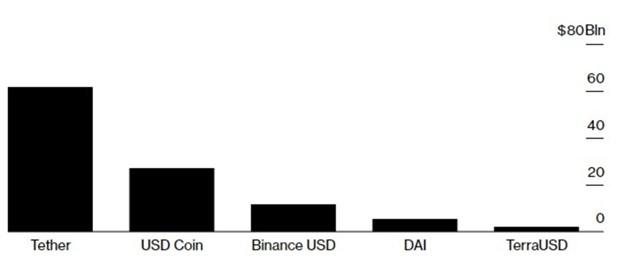Forex and commodities in crypto? Stablecoins explained

What are stablecoins?

Stablecoins are a new class of
cryptocurrencies that attempts to
offer price stability and is backed by a reserve asset. Stablecoins have gained
traction as they attempt to offer the best of both worlds-the instant
processing and security or privacy of payments of cryptocurrencies, and the
volatility-free stable valuations of fiat currencies (good old USD). Like all
cryptocurrencies, stablecoins are based on a blockchain – decentralized
database that stores the information in a specific way. Blockchain makes it
possible not to rely on one data center because every transaction and a ledger
itself is stored on every node (point of intersection) of the network.
While bitcoin remains the most popular
cryptocurrency, it tends to suffer from high volatility in its valuations. For
instance, it rose from $30000 to $58000 between January 27 and February 21,
2021, and fell from $64650 to $29100 between April 14 and May 19, 2021. It is
inconvenient to make payments with such a volatile instrument. Instead of it, stablecoins offer a way less
volatile solution. Collateralized by real-life assets, they are reminiscent of
fiat currencies, which are pegged to an underlying asset such as forex
reserves.
Even in certain extreme cases when a
fiat currency’s valuations move drastically, the controlling authorities jump
in and manage the demand and supply of currency to maintain price stability.
Stablecoins are here to help all cryptocurrency users find an island of
stability at the time of volatility.
Which types
of stablecoins are there?
1. Stablecoins Backed by Commodity
Stablecoins that are pegged against
commodities generally have the backing of hard assets for stability. The hard
assets could include real estate or gold. However, the most used hard asset for
collateralization of stablecoins is gold, with many stablecoins using a
diversified collection of precious metals. Some of the examples for such tokens
are Tether Gold and Palladium Coin.
2. Stablecoins Backed by Crypto Assets
Crypto-collateralized stablecoins are
backed by other cryptocurrencies. Since the reserve cryptocurrency may also be
prone to high volatility, such stablecoins are “over-collateralized”-that is, a
larger number of cryptocurrency tokens is maintained as a reserve for issuing a
lower number of stablecoins. For example, $2,000 worth of Ether may be held as
reserves for issuing $1,000 worth of crypto-backed stablecoins which
accommodates for up to 50% of swings in reserve currency (Ether).
3. Stablecoins Backed by Fiat Currency
Fiat-collateralized stablecoins
maintain a fiat currency reserve, like the U.S. dollar, as collateral to issue
a suitable number of crypto coins. They are extremely popular, mainly because
they are considered to be a printing machine of the cryptocurrency economy and
because they provide stability in eternally volatile markets. To comply with
strict regulating regulatory requirements, they need to undergo an audit
procedure. The most popular fiat-collateralized cryptocurrencies in the world
are Tether (USDT), USD Coin (USDC), and Binance USD (BUSD), with a total
capitalization of over $100 billion.
4. Algorithmic stablecoins
(Seigniorage).
Algorithmic stablecoins use algorithms
to automatically increase or decrease digital currency reserves like real-life
monetary supplies’ managers do. There are mostly gone due to regulations.
5. Central banks digital currency
(CBDCs).
CBDCs are digital currencies backed by
a government’s central bank. They are a form of state-backed currency, just
like a banknote. They are backed by states, not corporations, or, in the case
of Bitcoin, the blockchain. Since they are tied to a state’s currency, CBDCs
will fluctuate along with the traditional currency. Most models of CBDCs are
fully regulated under a central authority. China was the first country to test
launch the Chinese Yuan as CBDCs in February 2021. In crypto community they
aren’t in favor due to 100% centralization and absence of anonymity.
Give it up
for Tether!
Tether or USDT is the biggest and most
popular stablecoin with an overall market capitalization of more than $62
billion!

Tether was specifically designed to
build the necessary bridge between fiat currencies and cryptocurrencies and
offer stability, transparency, and minimal transaction charges to users. It is
pegged against the U.S. dollar and maintains a 1-to-1 ratio with the U.S.
dollar in terms of value.
On the other hand, Tether has a
drawback. Tether has been accused of a lack of transparency and discrepancies
in its collateralized reserves. The US SEC was suing Tether, saying that the
company doesn’t have enough USD to collateralize every issued USDT. However, accounting
firm Moore Cayman attested an “assets and liabilities” report from
Tether in February. As of February 28, 2021, Tether held more than 100% of assets
to back the issuance of fiat and commodity-backed stablecoins. The US didn’t
stop there and after six months the Justice Department asked for reserves
confirmation. On August 9, 2021, Tether released another assurance report, once
again confirming that their reserves are fully backed.
With FBS you will be able to trade
cryptocurrency in pairs with USDT. It is reliable, fast, and popular. Don’t miss a chance to catch the volatile
cryptocurrency moves with FBS!
What are the
risks?
Probably the biggest stablecoins risk
is centralization. Stablecoins must be collateralized with some asset, you
can’t just mine it like a Bitcoin or earn as a reward for being an active
member of the network. Therefore, even though this is still cryptocurrency, and
all transactions are visible to everyone, irreversible and safe, the issuing of
new tokens is in the hands of few. Some people were accusing stablecoins
issuers of pumping the cryptocurrency market with constant tokens printing.
Cryptocurrency is young and ambitious finance
industry with rapid growth and constantly emerging opportunities. Make sure you
will not miss the train!
Stand by for more articles about the cryptocurrency
industry, and trade with FBS!
You can trade crypto with
FBS in FBS Trader app or Metatrader 5.
Disclaimer
This
post is written and submitted by FBS
Markets for informational purposes only. In no way shall it be
interpreted or construed to create any warranties of any kind, including an
offer to buy or sell any currencies or other instruments.
The
views and ideas shared in this article are deemed reliable and based on the most
up-to-date and trustworthy sources. However, the company does not take any
responsibility for accuracy and completeness of the information, and the views
expressed in the article may be subject to change without prior notice.








